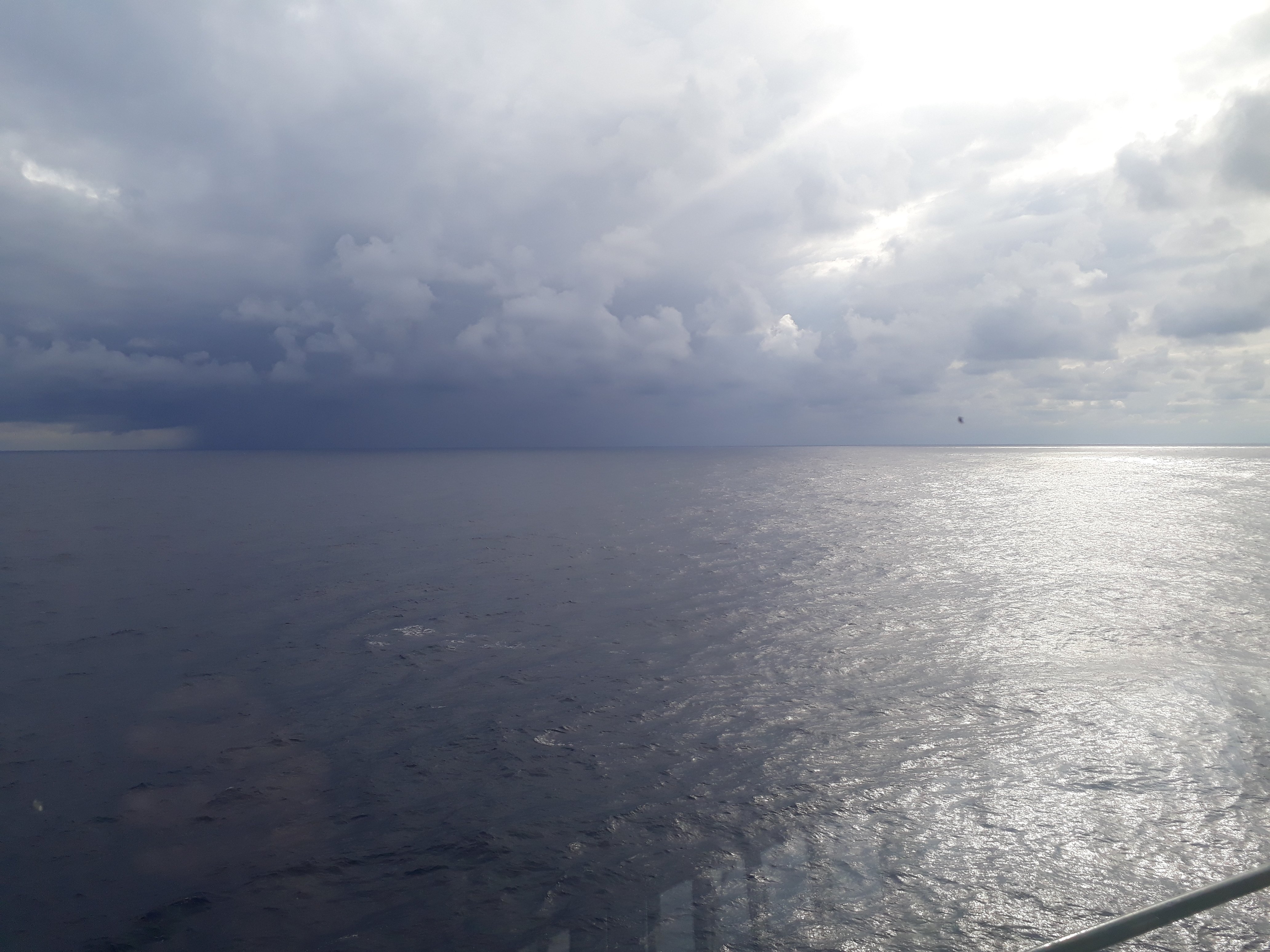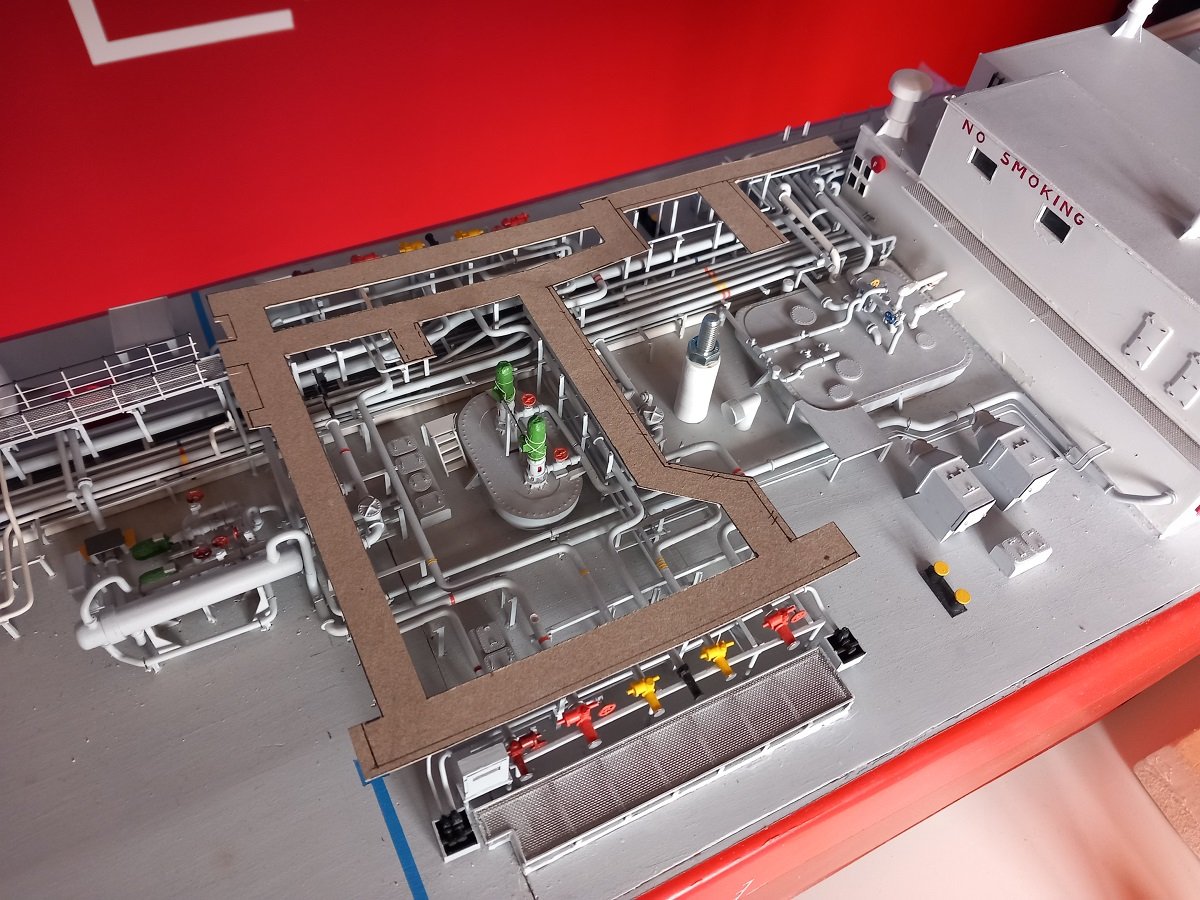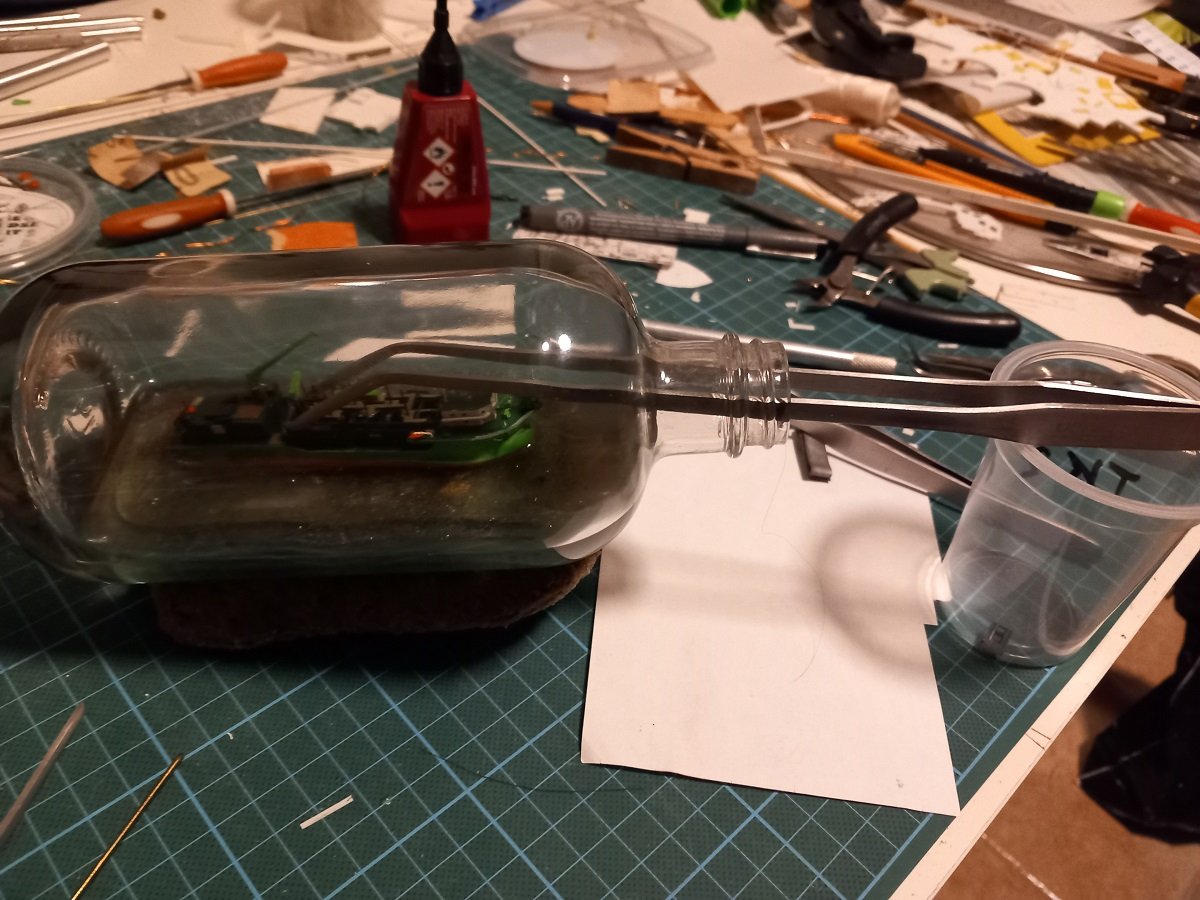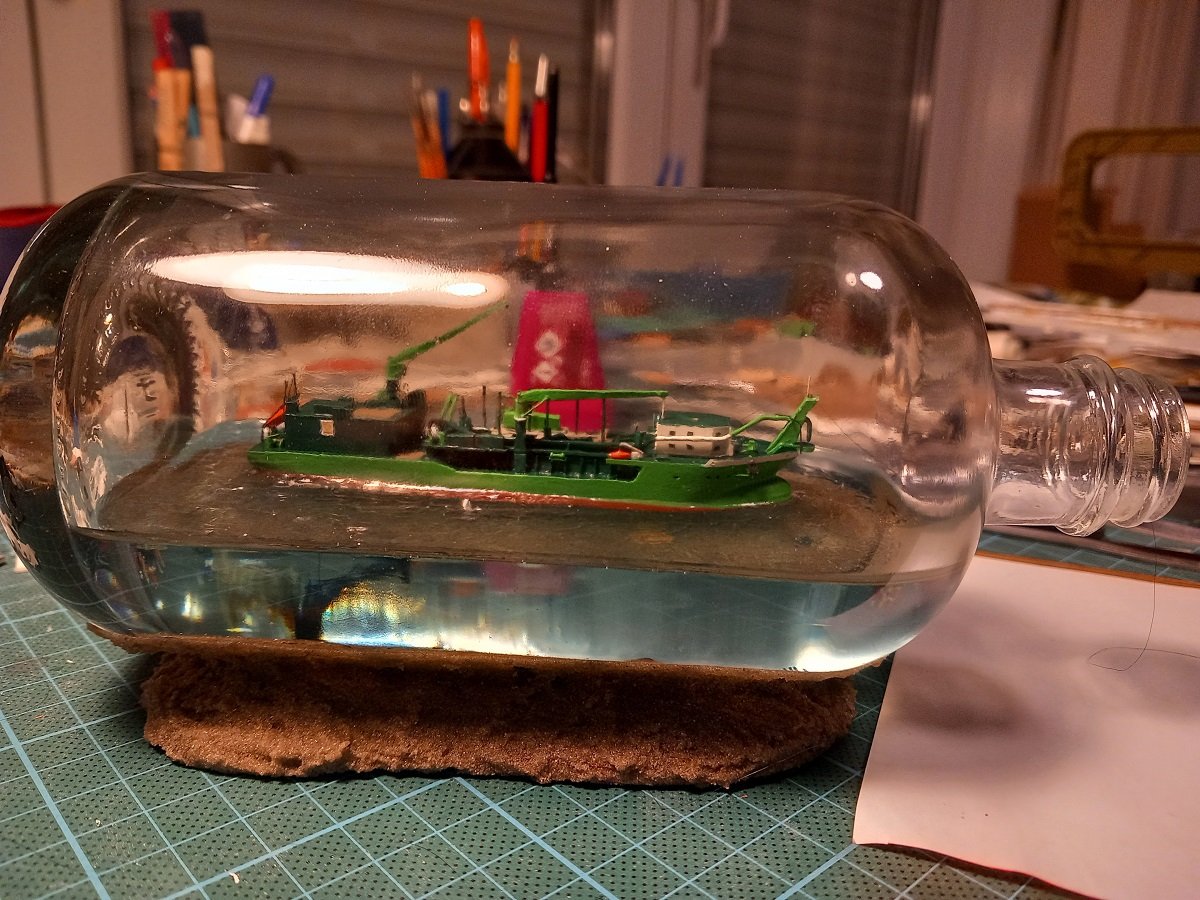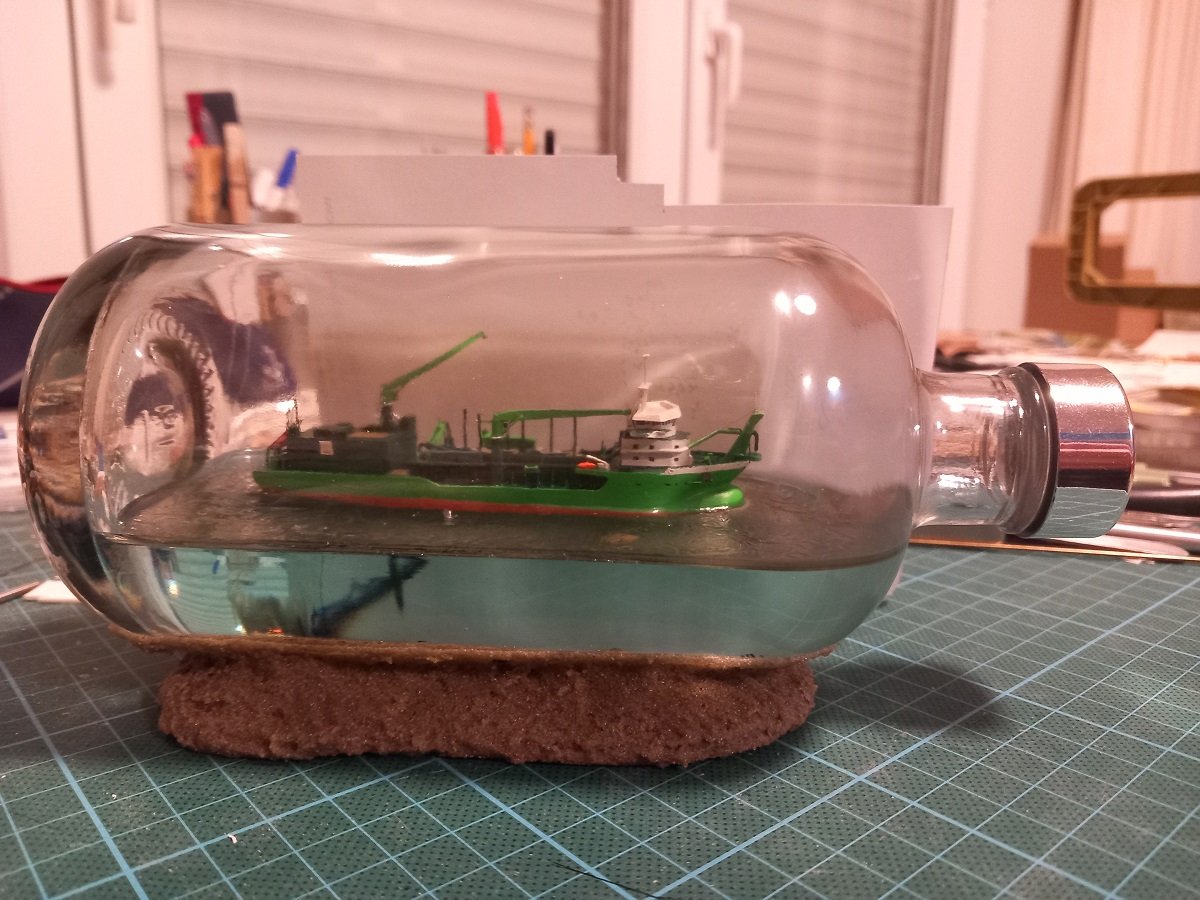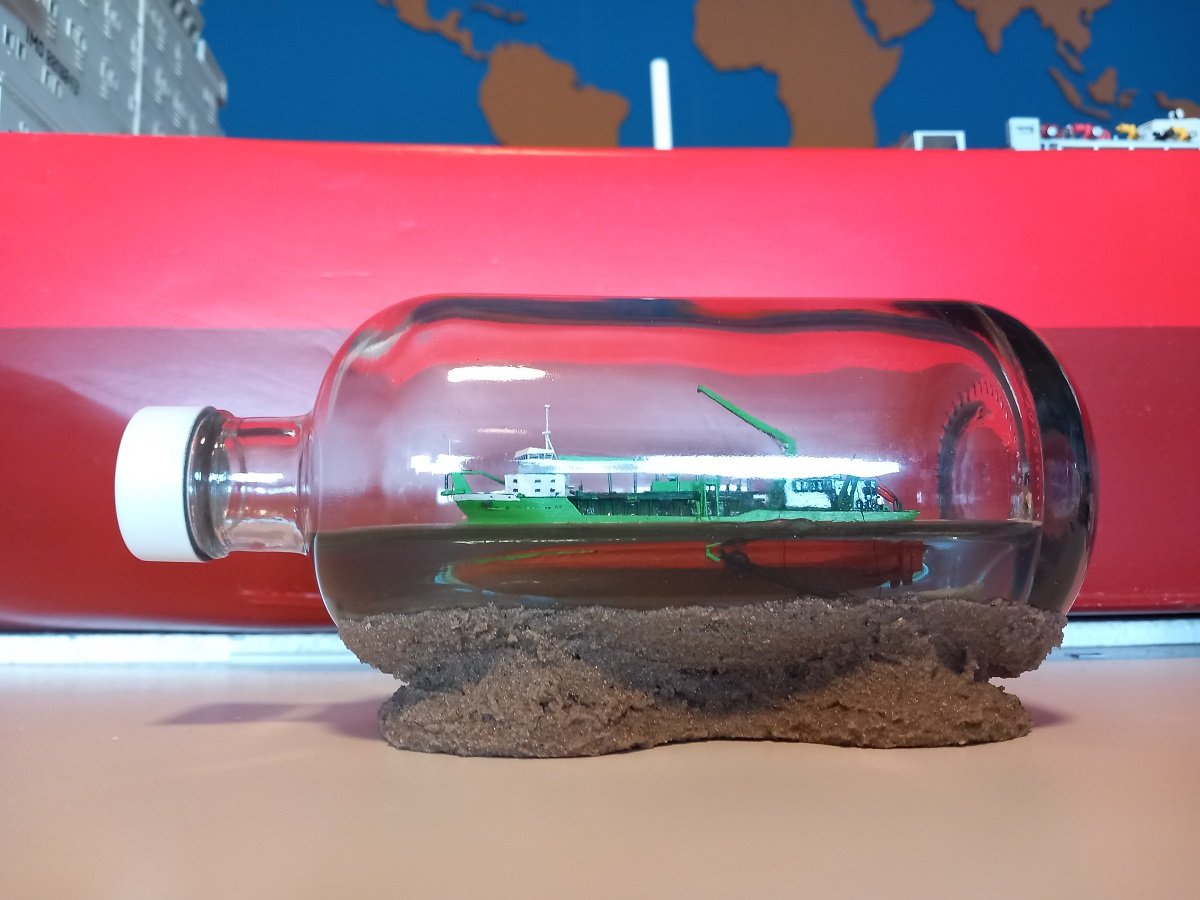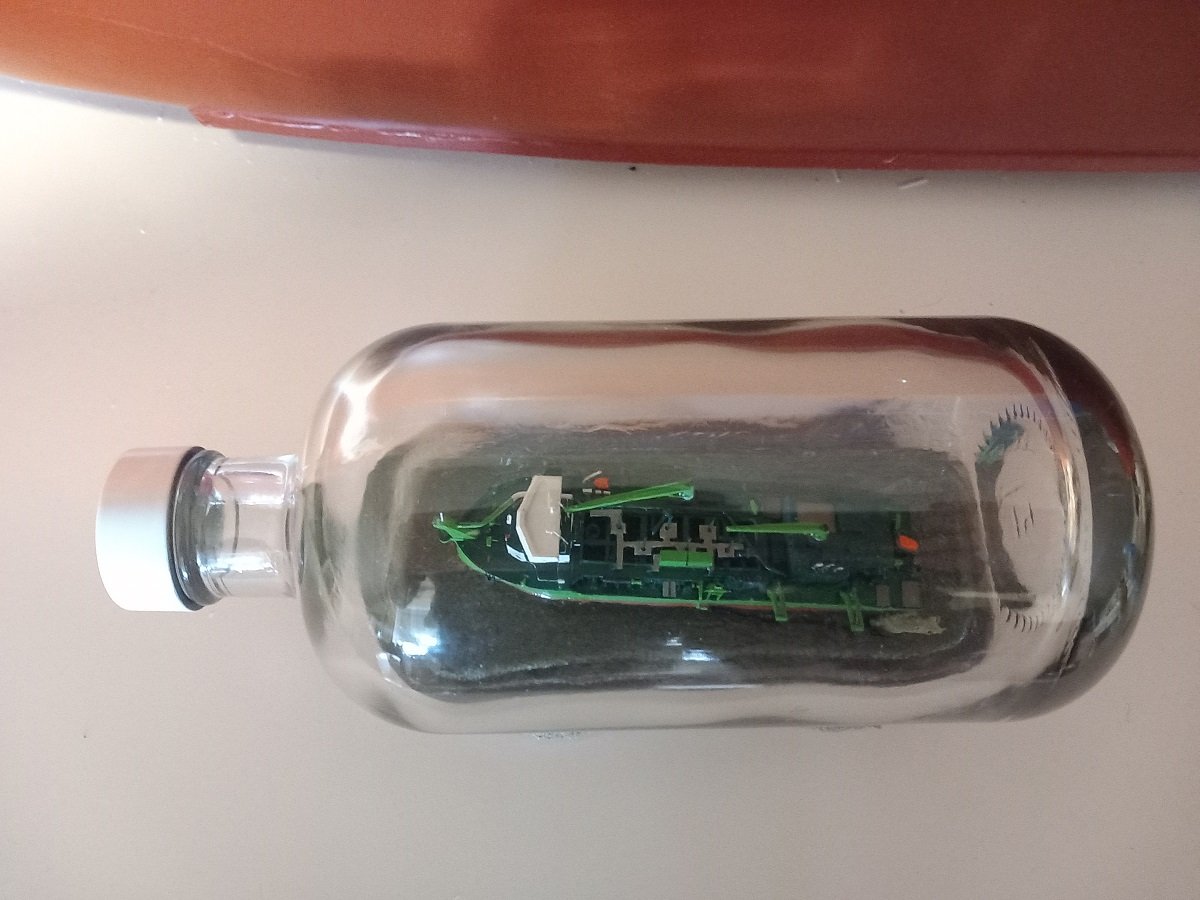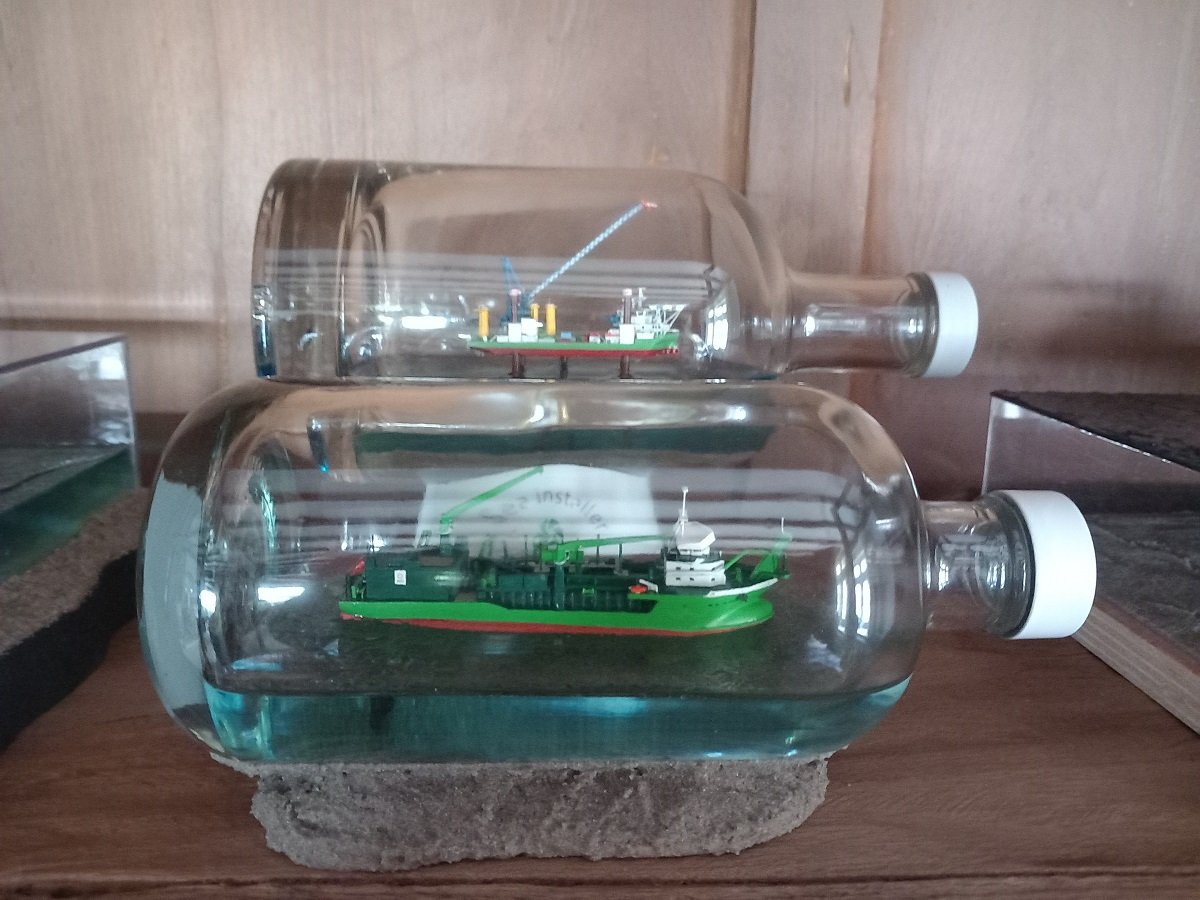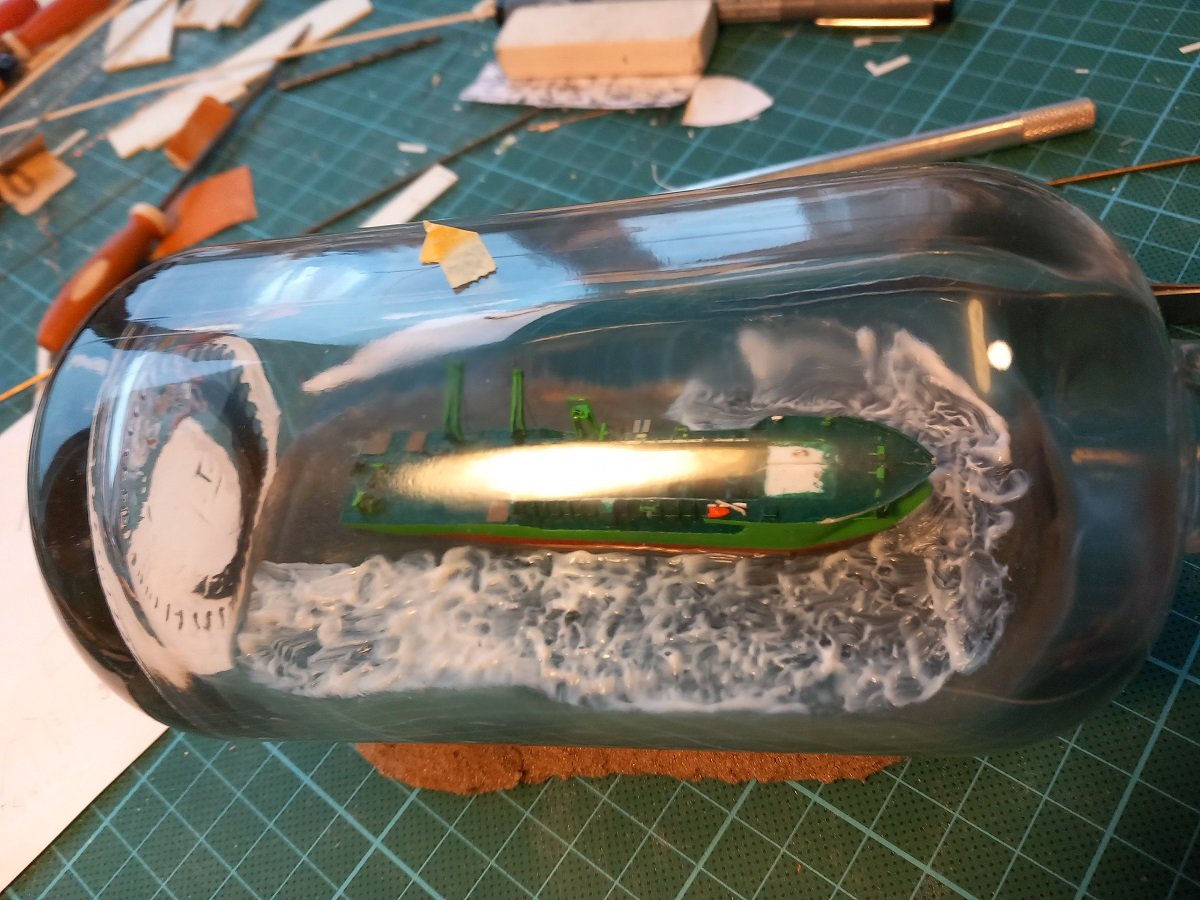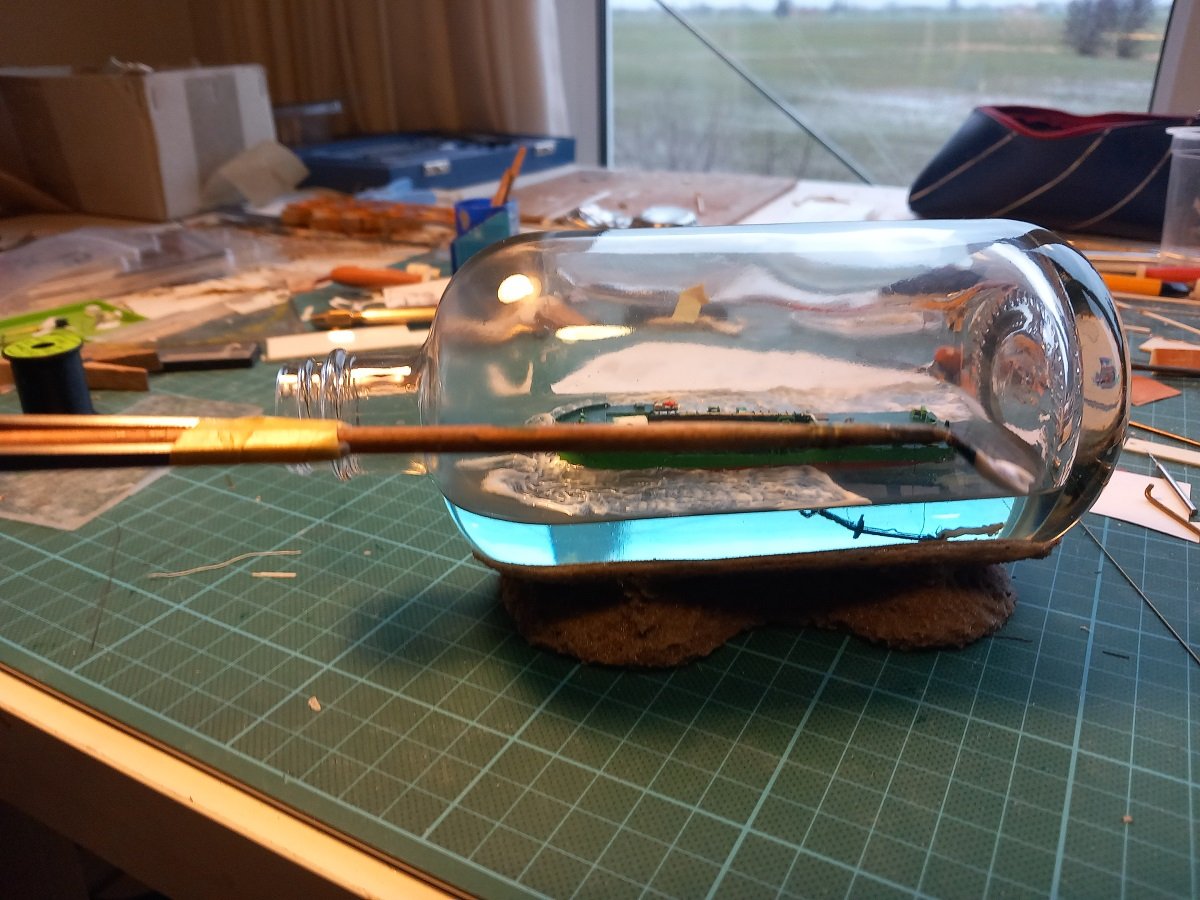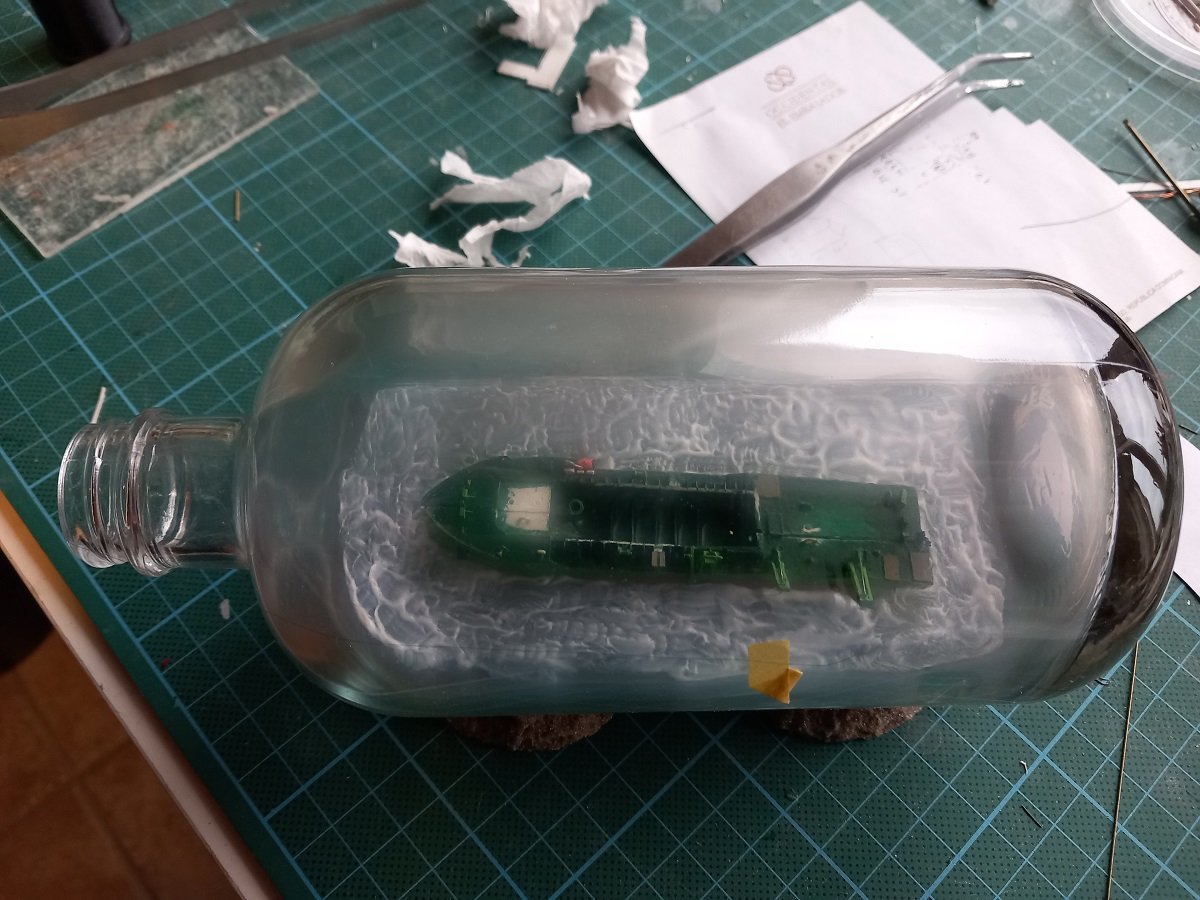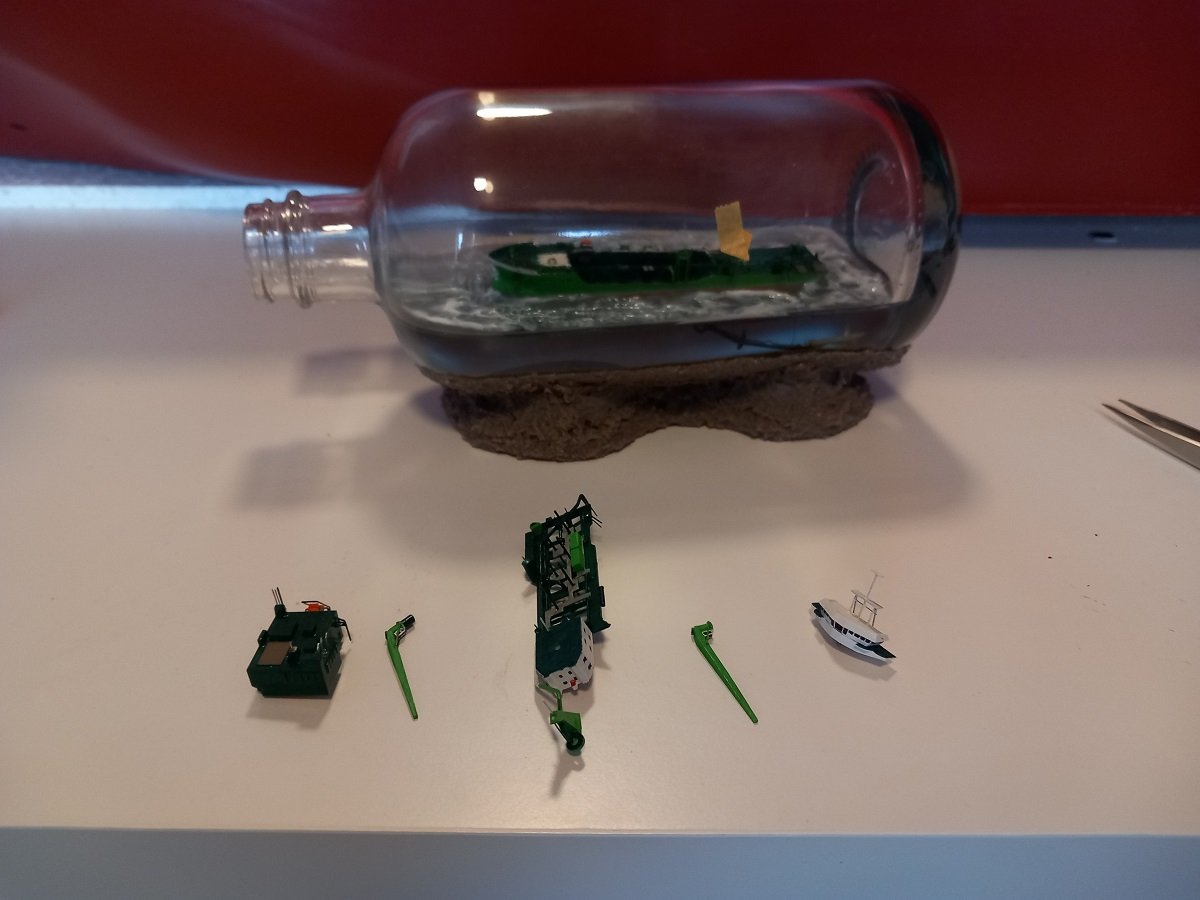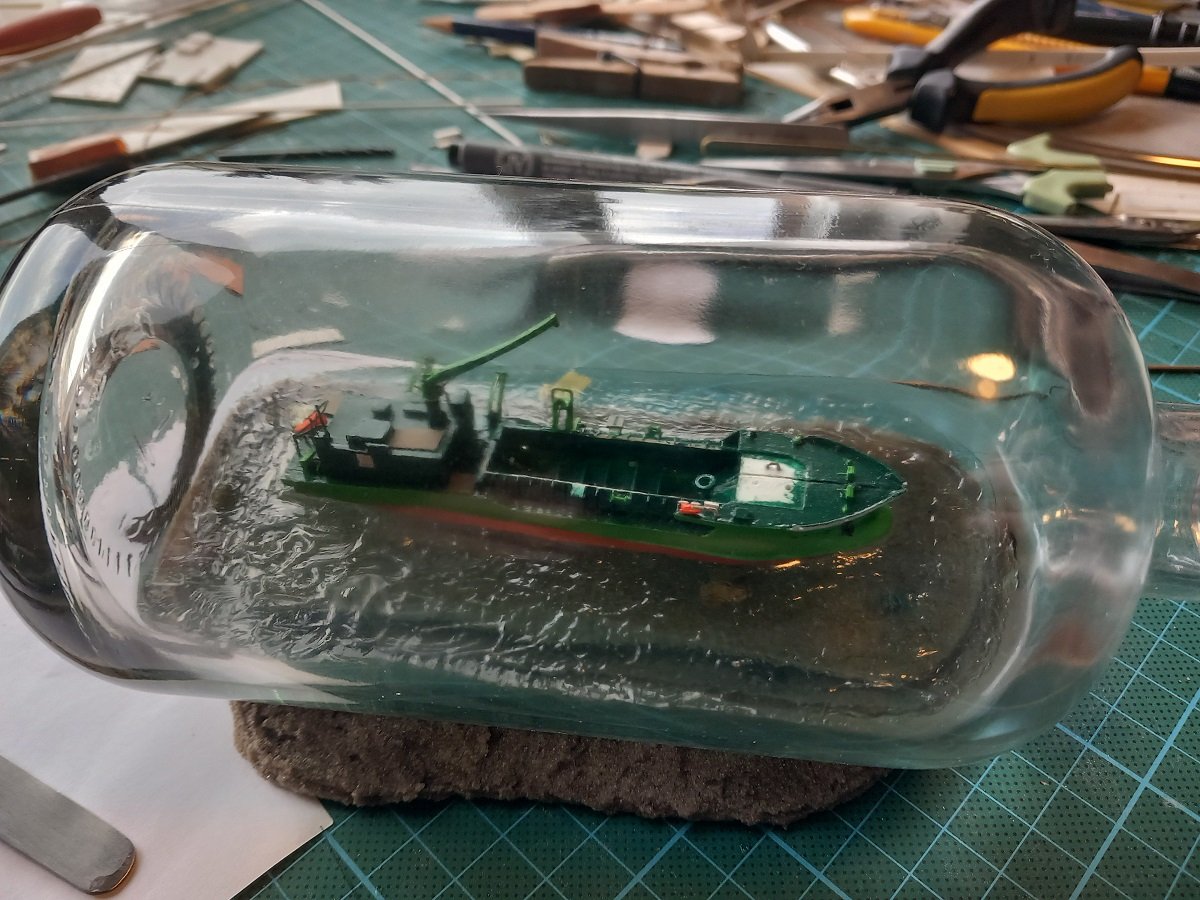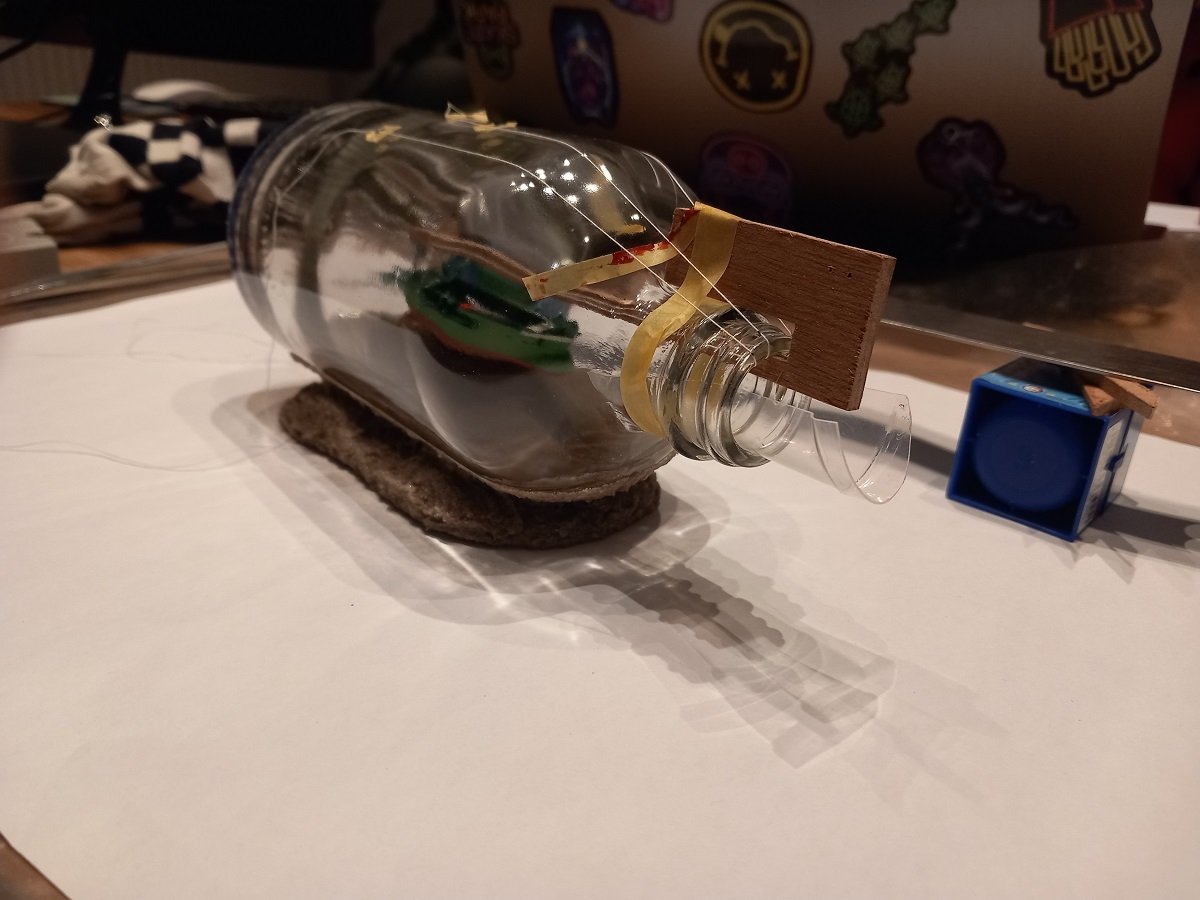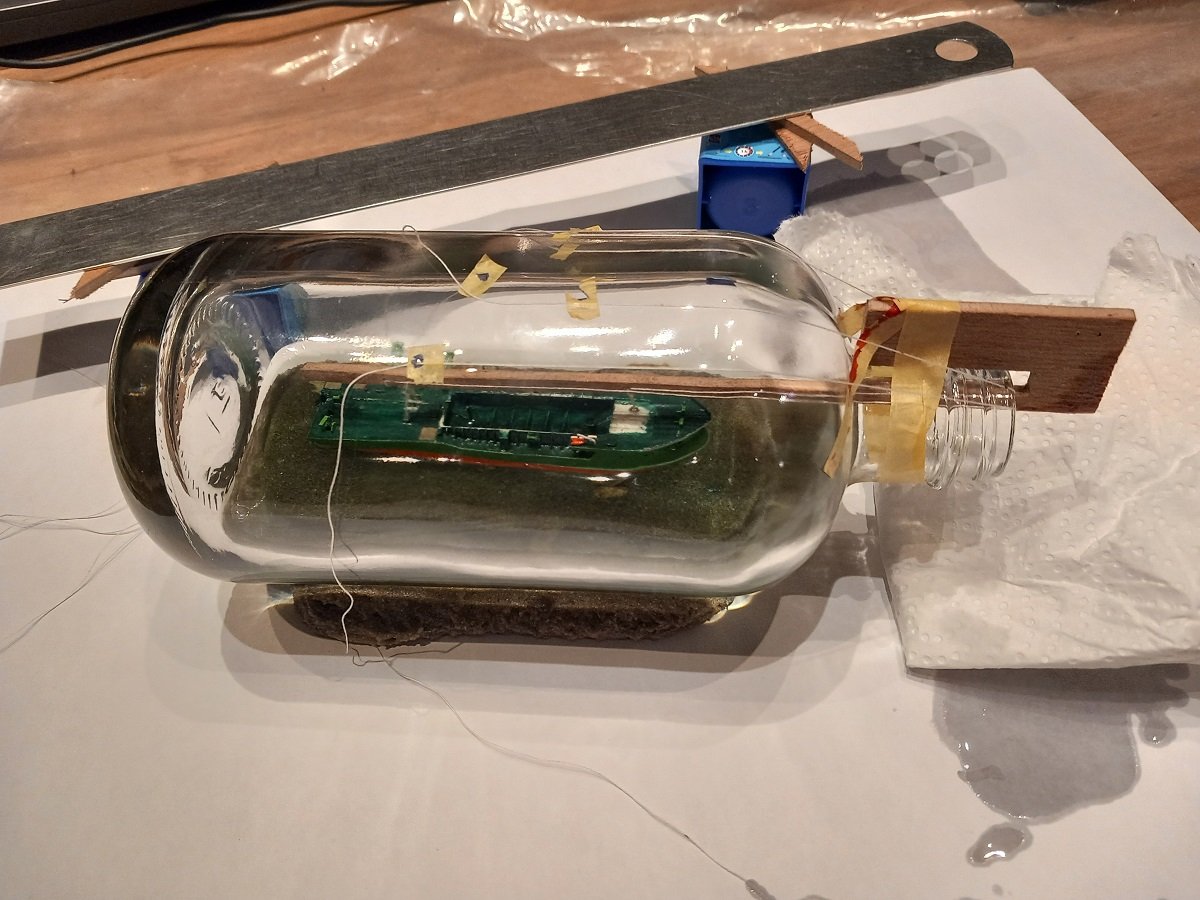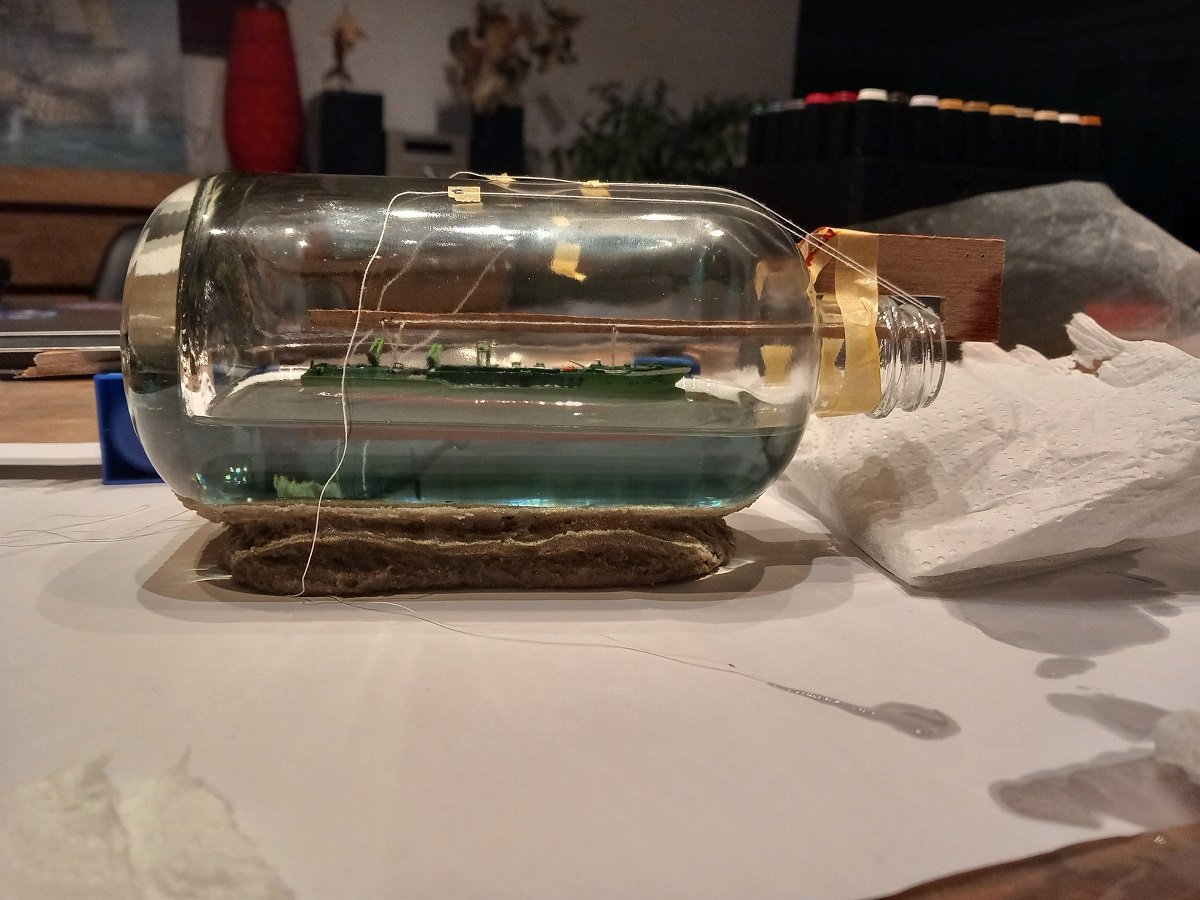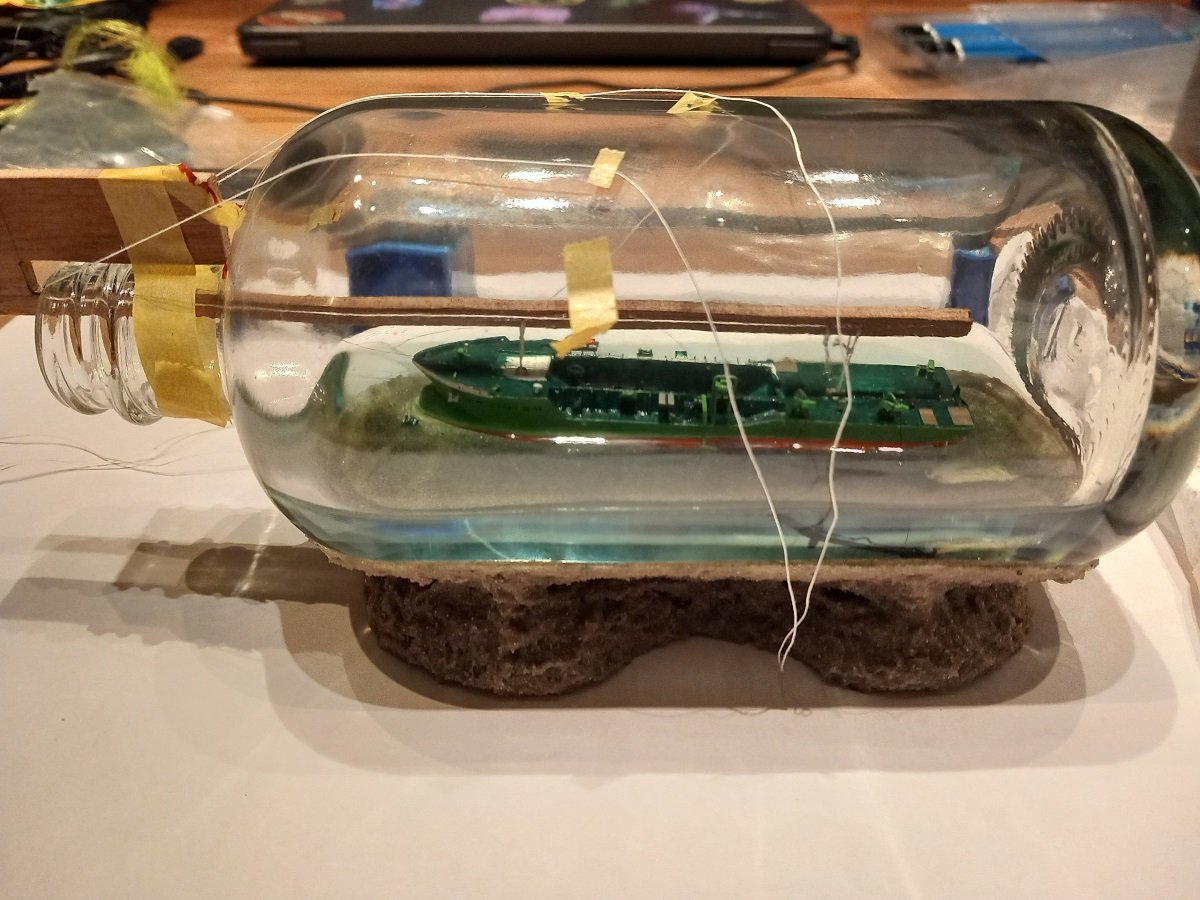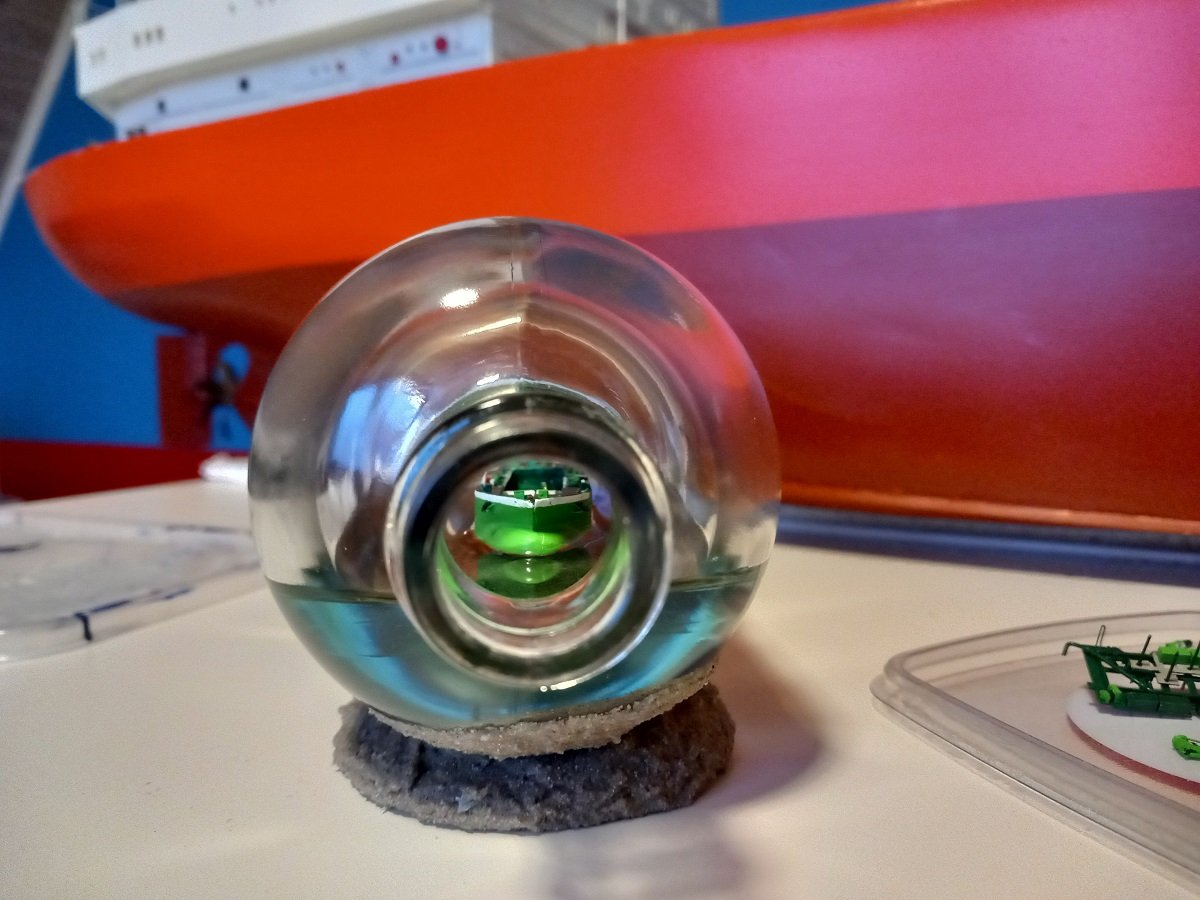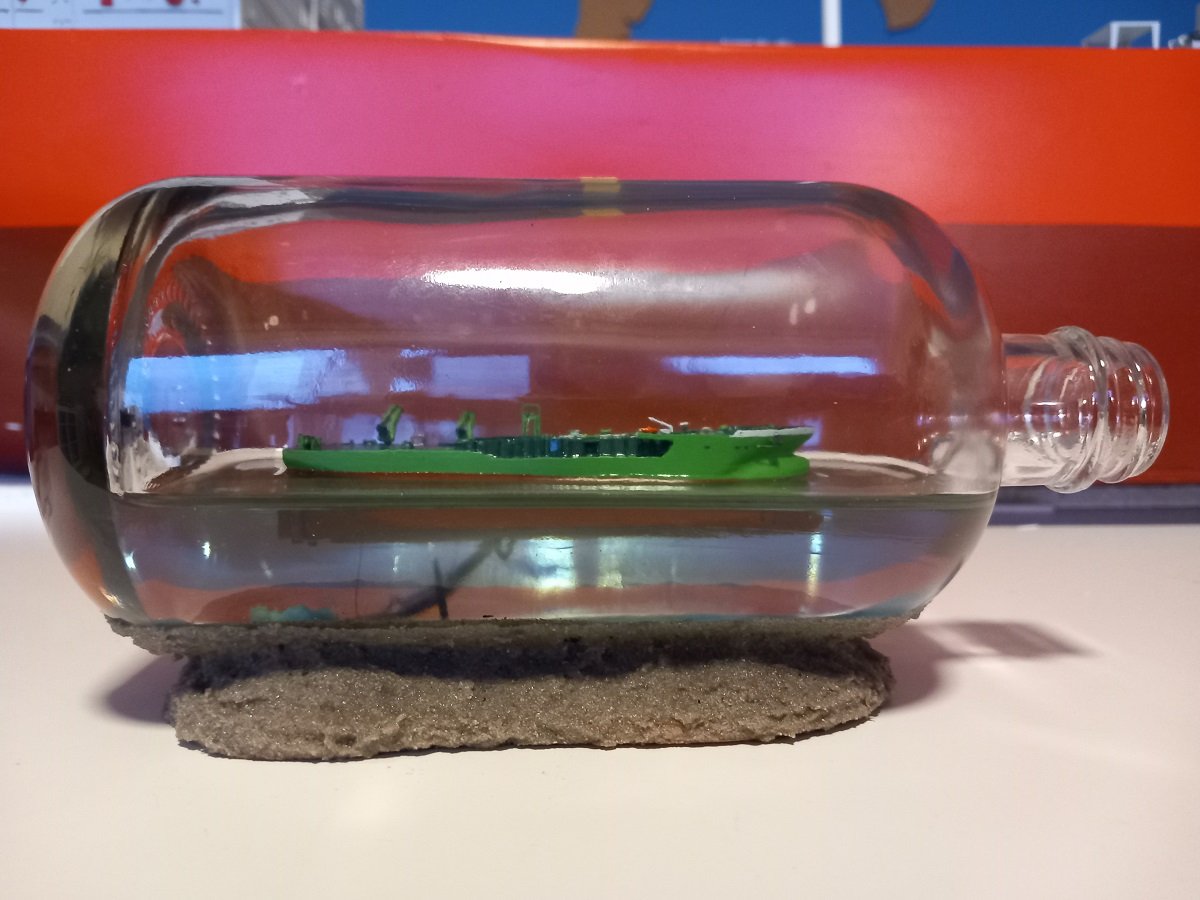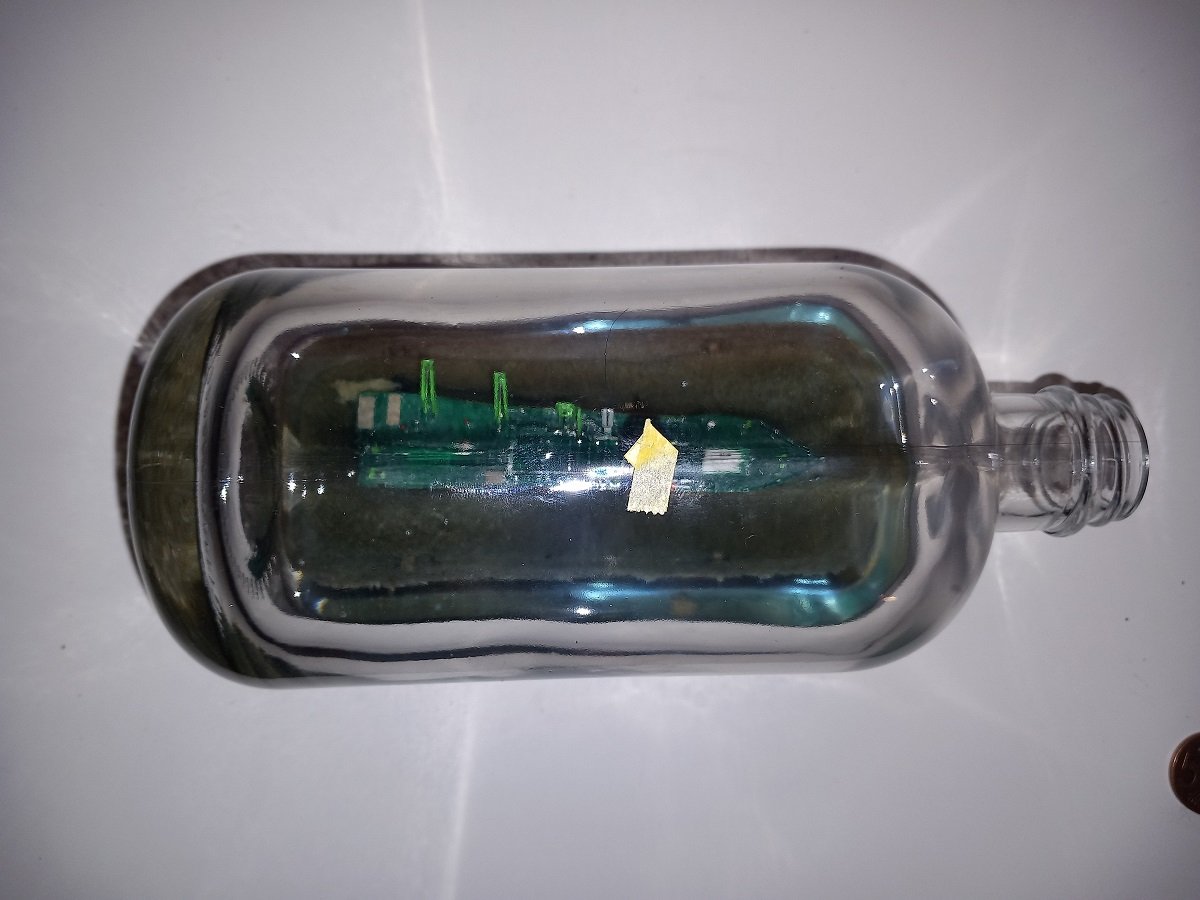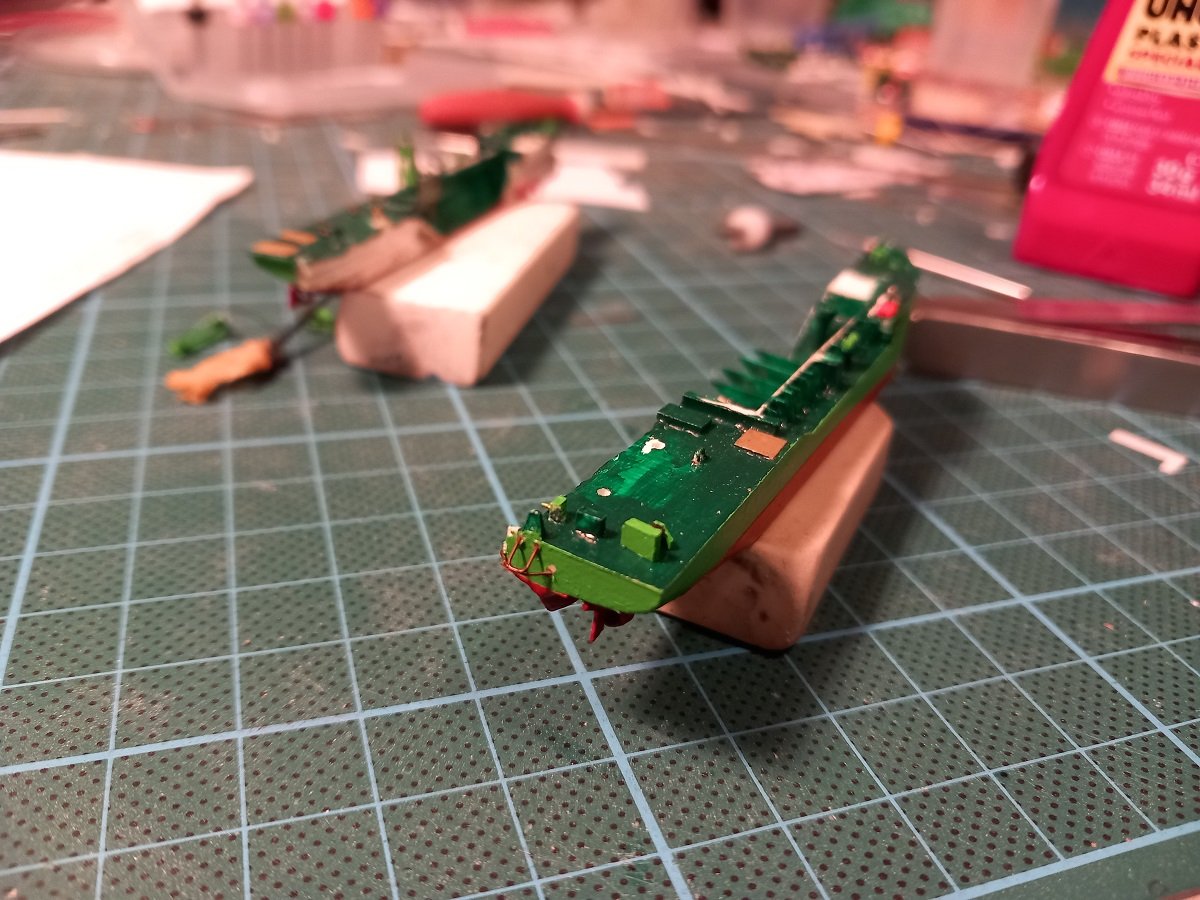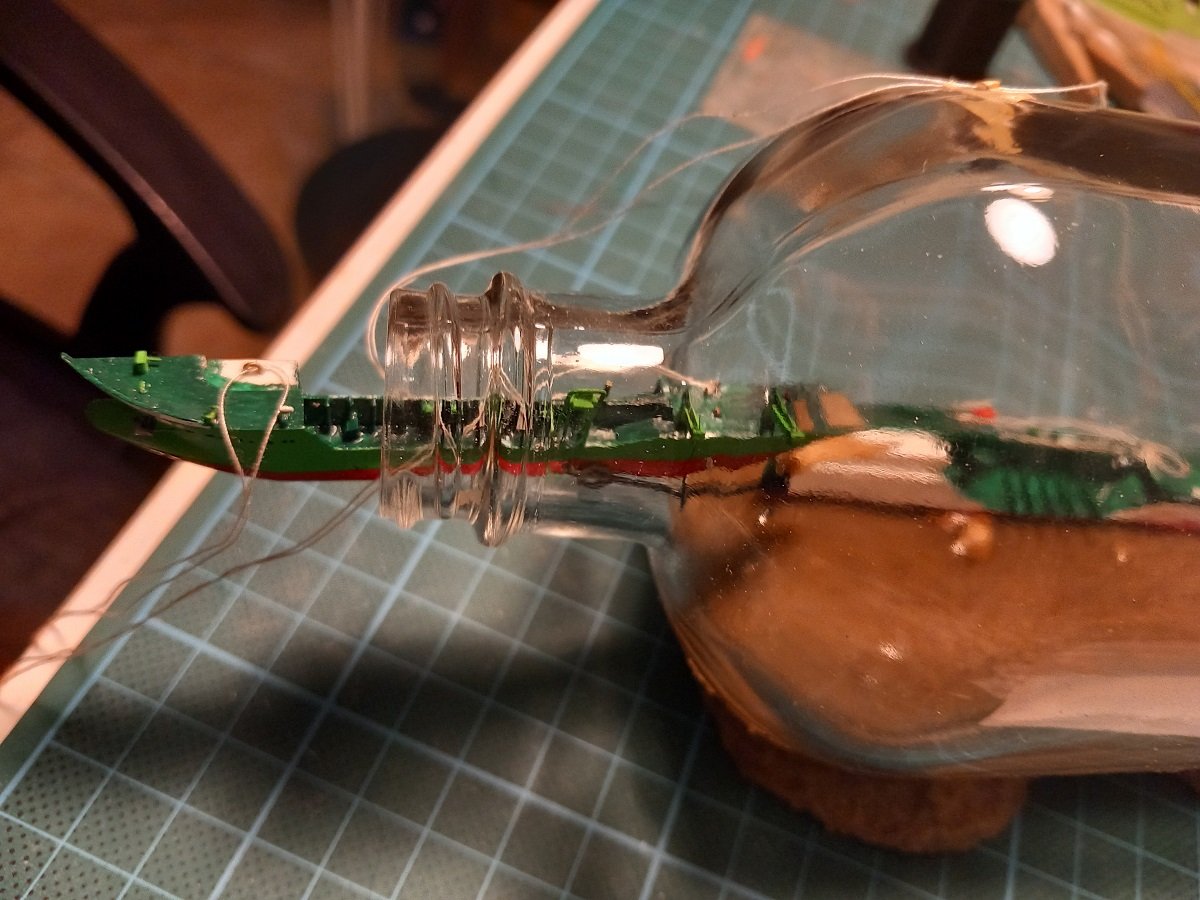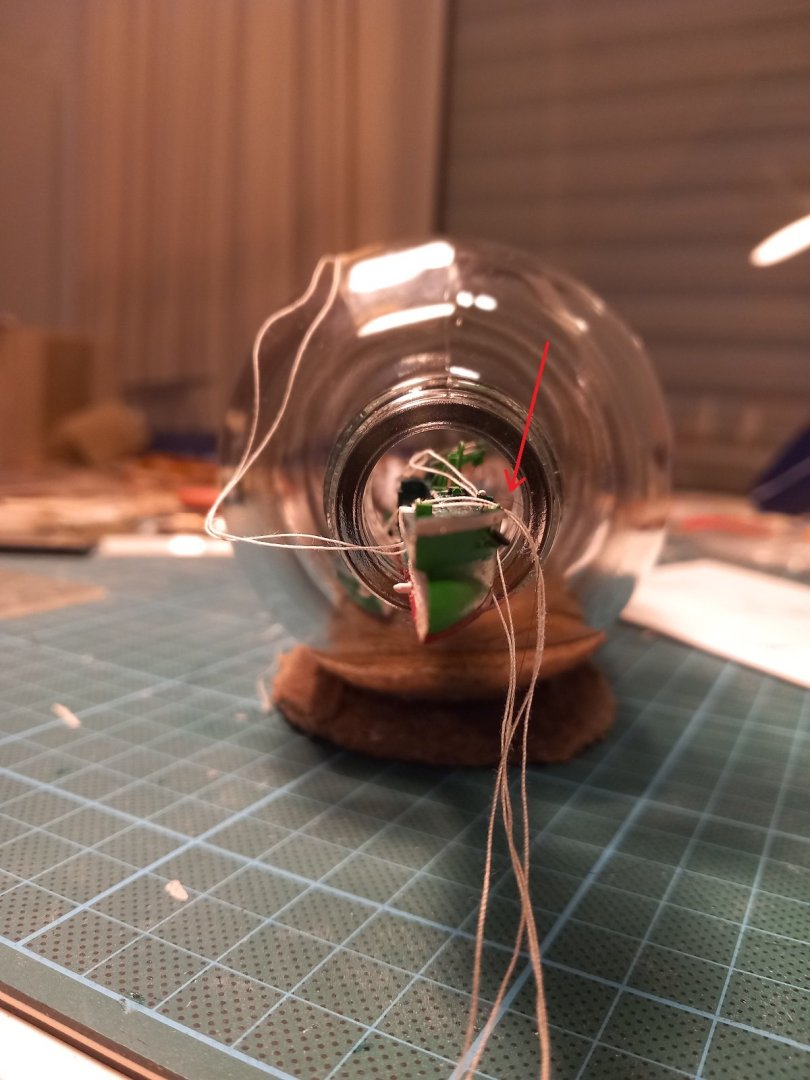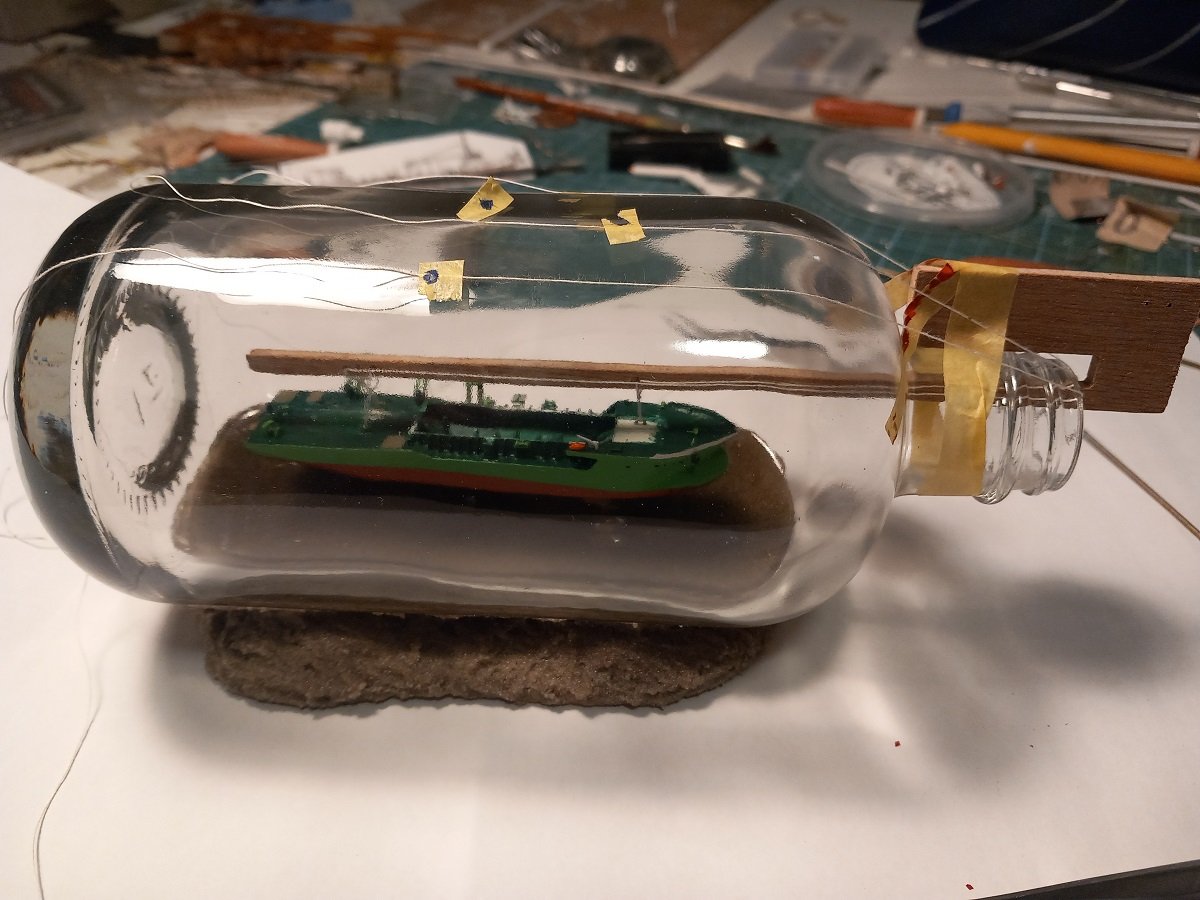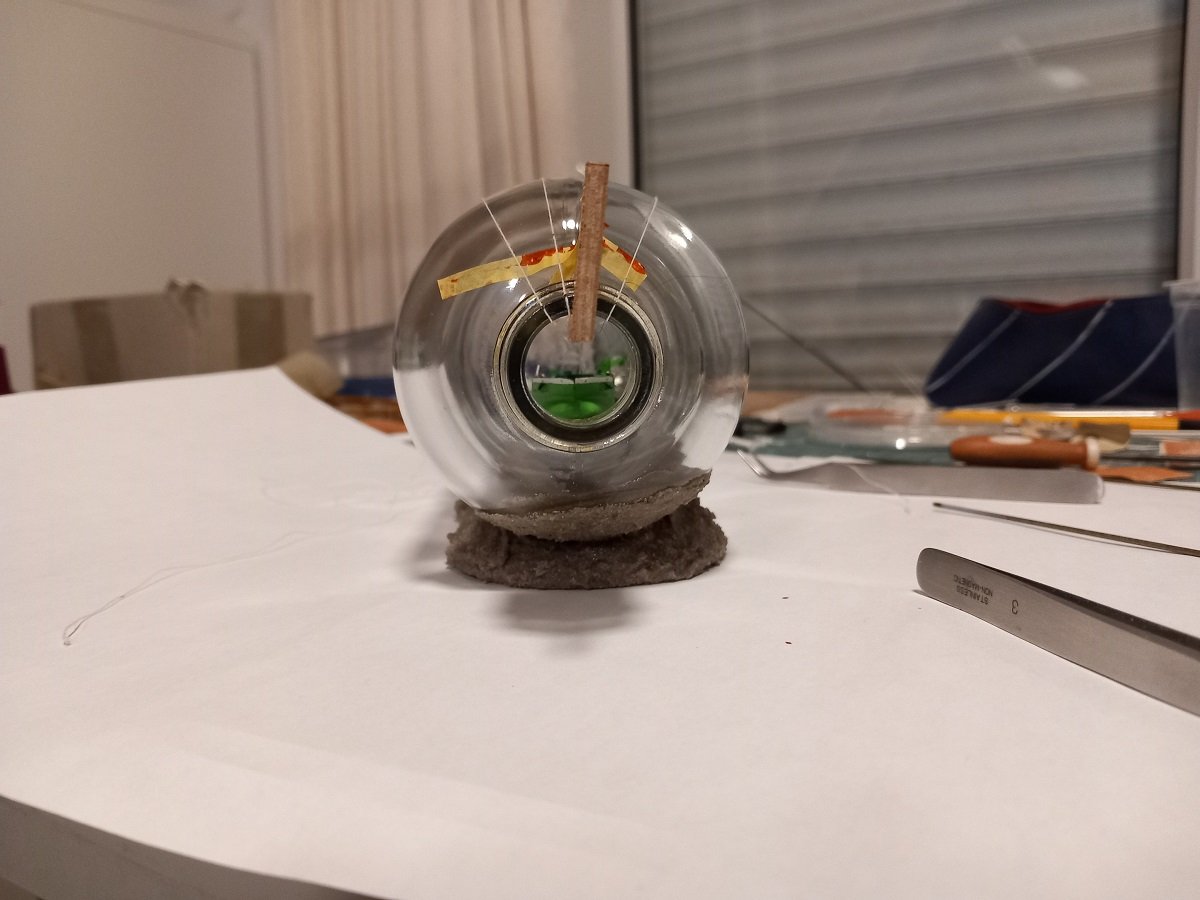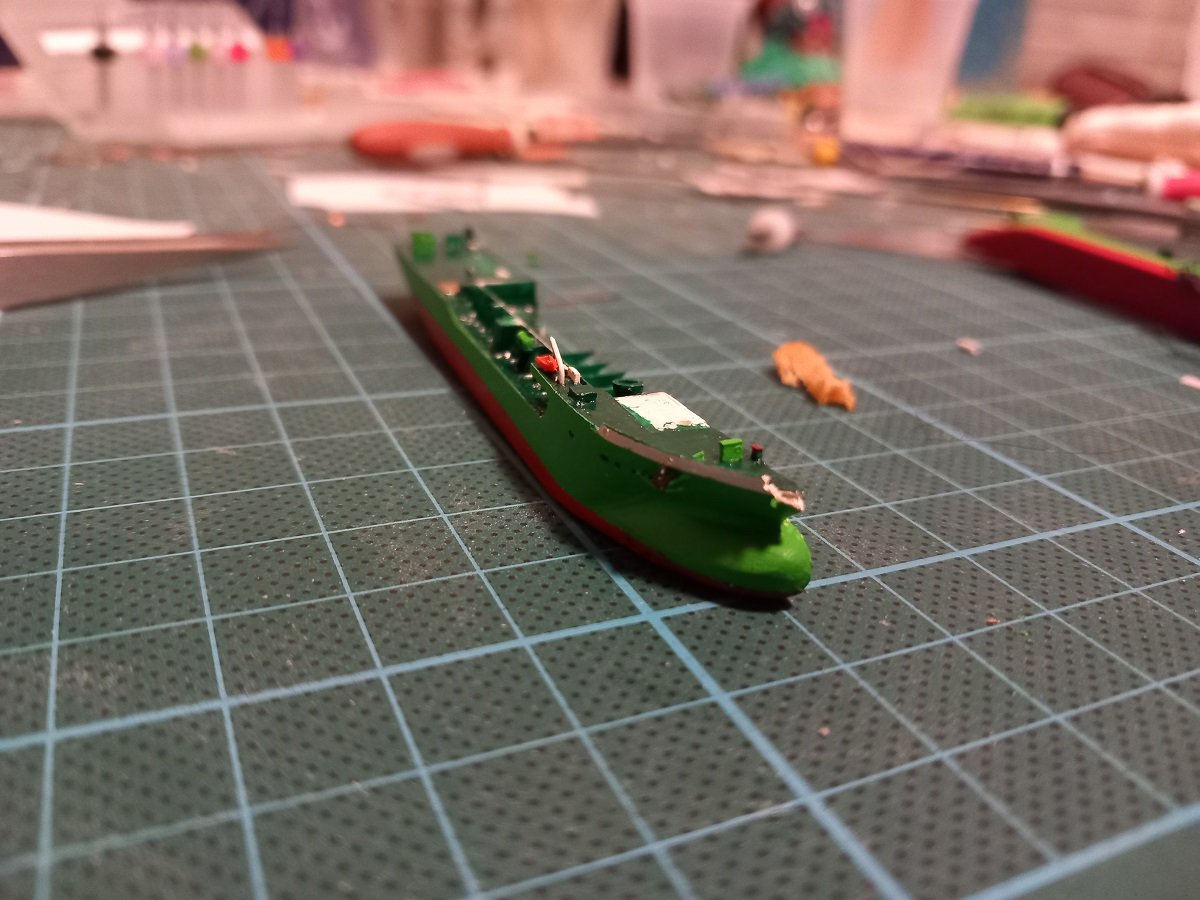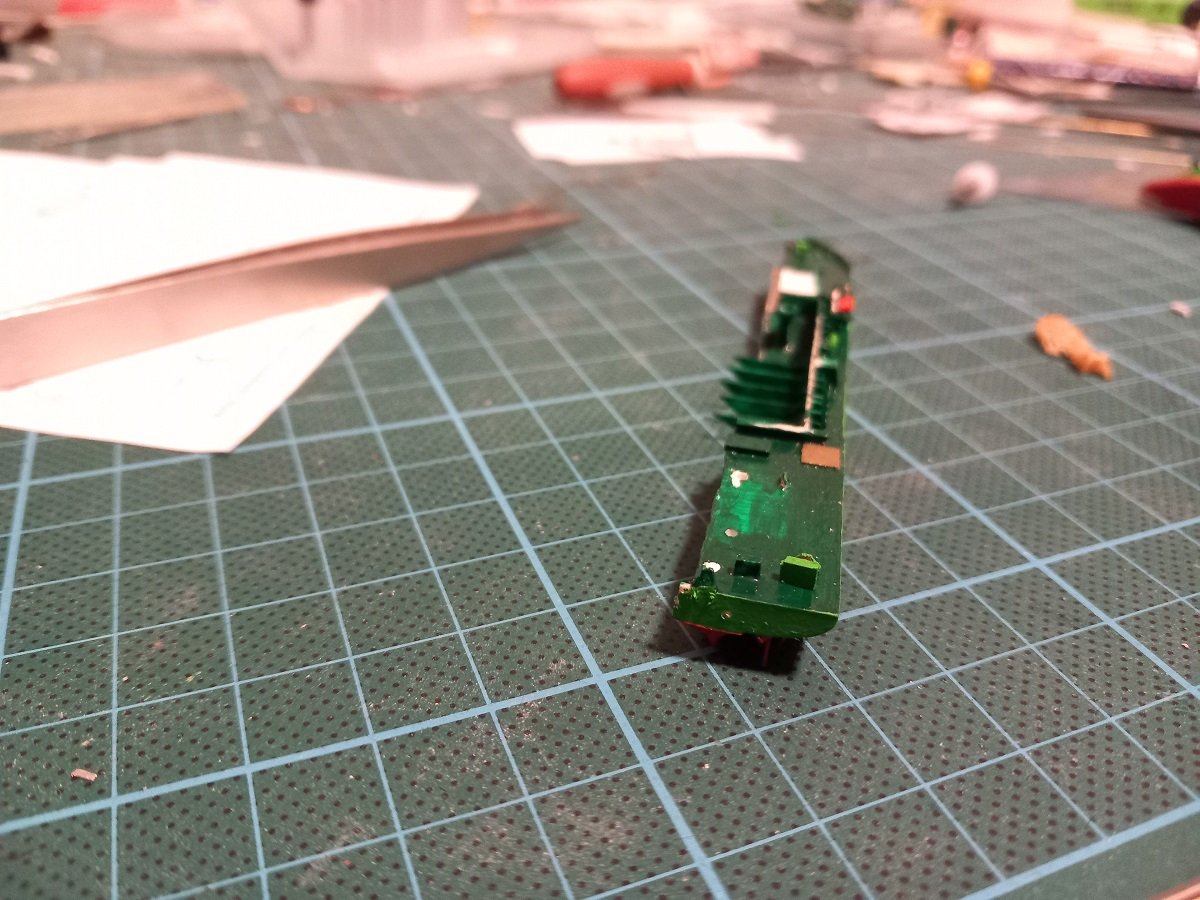-
Posts
618 -
Joined
-
Last visited
Content Type
Profiles
Forums
Gallery
Events
Everything posted by Javelin
-
After my little foray in the SIB theme, it's time to get back to this one. I had a few options, I guess I want for the most logical one and that is going forward from where I left off. So this is the area I'll be concentrating on for now. A cardboard template of the catwalk in that area is fitted to check out for size and fitting. Slight adjustments are required to let each part fit. However first I'll need to do that details on the lower levels inside the catwalk area. I'll probably destroy that catwalk if I'd put it on first. So you can see that white, unpainted structure with stair, that's one of the pieces that still needed to be made. That set me off on a whole series of small stairs. Basically each tank dome has a small 4-step stair to the main deck, so I started making all those first. This jig is about as old as the model itself, not perfect, but still good enough. It also allows to adjust angles for the different stairs etc. And the first ones are there. The one connected to the platform is a bit too flat, the angle isn't correct, so I'll change it by a steeper one. And the additional details required on the tank dome are the instrumentation box, cabling between the two pumps (similar to the aft tank dome) and the handrail. For the instrumentation box I needed to make the legs. To get it firmly on that deck, the legs are drilled into the deck before gluing. First I made a template based on the box bottom itself. I drilled 4 holes to fit the corners of the box. I then used that template to drill the holes in the deck. I then cut the legs to length, glued them to the box and used the template again to get them straight, so they'll fit in the holes in the deck later on. So here you see the glued legs to the box in the template. Hopefully it'll fit nicely in the deck now.
-
That's not a very true assumption, rope rarely, depending on the lay of it, has a tendency to coil up round. It generally depends on the lay, direction of coiling and simply the motion that is made during coiling that would define the shape of it. I must admit this is looking more like a coil that was made vertically, hanging and then laid down afterwards rather than a coil that was made straight on deck. But honestly... if that's the only question we can pose, he's doing a great job. And that's what this is! Great work all around, astonishing work and VERY Tiny blocks indeed!
- 2,696 replies
-
- heller
- soleil royal
-
(and 9 more)
Tagged with:
-

HNLMS Jacob Van Heemskerck postcard
Javelin replied to Ferrus Manus's topic in Nautical/Naval History
Not sure if this will work, but plenty of plans of that ship on the Dutch national archives. Jacob Van Heemskerck -
I think I'll make a half-hearted attempt at 4 frames of a ship and then go to Glen in despair and ask him to finish it for me 😁. I know, the starting point here was by no means half hearted, but if Glen can do it better, why make the effort...😆. Joking aside, regardsless of some historical accuracy issues (perhaps), you're doing a marvellous job here!
- 301 replies
-
- Constitution
- Bluejacket Shipcrafters
-
(and 1 more)
Tagged with:
-
I kind of regret you're finished. She was a pleasure to follow and came out beautiful! Love the way you did the sails, brings an extra dimension to the build. I'm sure you learned a lot of things and will use those lessons in the next build.
- 222 replies
-
- sultana
- model shipways
-
(and 1 more)
Tagged with:
-

Neverland Hobby - is this a legit model manufacturer?
Javelin replied to bruce d's topic in Plastic model kits
Seems indeed the shop in Bruges (not Brussels, very insulting for Bruges 😋), is called Hobby Neverland, while the manufacturer is Neverland Hobby.... -

Neverland Hobby - is this a legit model manufacturer?
Javelin replied to bruce d's topic in Plastic model kits
You are talking about a shop near Bruges. I've been there in the past. It's a shop, as far as I know they don't produce anything and are therefore different from the manufacturer Bruce is enquiring about. -
I saw most of your updates by the posting on the main page, but seem to have missed quite something now. Finally following this topic, better late than never I guess. Great job on Lula, she looks very realistic. Having some gaps left and right is good in this case. She was pre industrial mass-production and therefore likely to be less sharp and crisp as anything built later on. Hope you didn't get hurt too bad from that fall...
- 732 replies
-
- Lula
- sternwheeler
-
(and 1 more)
Tagged with:
-
YES PLEASE! A dredger would be fantastic! However, first Lula. A gorgeous piece of work and a great example of combining materials to reach an overall complicated appearance! True scratchbuilding. I can't imagine, but do hope, to be building such sharp and intricate details at your age.
- 732 replies
-
- Lula
- sternwheeler
-
(and 1 more)
Tagged with:
-
As the title says, I'm preparing for a first wooden ship and decided to go for a scratch build. The odd reason perhaps, is that I'm used to build from scratch and want to see where it goes. I find it easier to toss one of my builds in the bin rather than a 30% finished (expensive) kit. Now while preparing I've been gathering a lot of info here on thicknesses and types of wood, but I do have to take in account what I have available to me. The basic question is: Do I use ply or MDF for the frames and keel? I've seen some opting for MDF because it holds pushpins better, but that's just one argument. And second question, my main store has poplar and birch ply, so if I'm to use ply, which one would be better suitable? I'm preparing a document with sequence of construction and needed materials, so I can make an order list for the first phase. As mentioned before, if the hull fails, there's no need to purchase equipment for masts, fittings and rigging, which is not an option if you bought a kit... (considering my past experience and wealth of information here, I'm rather confident I can make it work, or I wouldn't start it in the first place 😄)
-
Hi @Glen McGuire, we don't really use much piping like that onboard, most of it bolted or welded. Bolted flanges maked things easy to remove for repair or replacement. There are not many things that survive long on a dredging vessel. I've somewhat settled on the US M53 or M54 aerial depth charge for the name card. Why? Well, because I have good drawings of it and the beam/length ratio is good for writing the name of the ship and scale on it without becoming too large and overwhelming compared to the ship and rest of the base. I'm thinking about partially covering in sand or weathering it differently.
- 70 replies
-
- Scheldt River
- Dredger
-
(and 2 more)
Tagged with:
-
So they're calling you an Apprentice now... I wonder what the Masters' works look like then?! That crack makes me bit sad. Looks a bit like you made the model and inserted it through the bottom, gluing the cracked part in, together with the ship. Nowadays anybody can photoshop the crack away and state it's a "before" picture 🤪. In all honesty, I really am sad and can't imagine this happening to one of my builds. I hope it's not the result of differing temperature expansion factors between the epoxy and the bottle (perhaps in combination with a small impact?). That said, the Jenny does look awesome. Love those sails!
- 301 replies
-
- Constitution
- Bluejacket Shipcrafters
-
(and 1 more)
Tagged with:
-
Takes a gas carrier guy to think of such things ;). Changing atmosphere in gas tanks is done in the same way, except that those pipes are fixed of course. @Glen McGuire, I didn't put too much pattern in those waves since I knew it would shrink that much. In this scale, the shrinkage of the gel is actually an advantage. Time to finish this up, there really weren't that many manipulations to do anymore. As mentioned yesterday, shouldn't forget to pass the unicaenis through the bow connection before inserting, otherwise it would get really hard to pass it inside that bottle. There was a slight bend in the main part, with either the accommodation or the aft end wanting to come up. So eventually I glued the forward part first and had to get creative to hold the aft part down while the glue was setting. What are you looking at? Well the aft end of the tweezers is resting on a cup, while the bottle is resting on the center of the tweezers in way of the bottle neck and the open end of the tweezers is pushing down the aft end of the main deck on both sides using the weight of the bottle... I'm not good at holding such a position manually for longer periods of time, I'd probably crush the model or release too early! Hence this idea to let gravity do the work. After some testing when still outside the bottle, I found out that mounting that bridge without knocking the forward crane boom off its support was quite hard. So I decided to glue that boom quite well to its support and I also found out the correct way to mount the bridge to avoid getting stuck on that support. Luckily my ideas worked out the way they were supposed to. And the last action was adding a dab of glue to that bow connection, pulling the unicaenis tights and eventually cutting off the unicaenis inside the bottle. I don't like shiny bottle caps, certainly not with this kind of working vessels (shiny on a vessel like that means it's probably damaged). So I decided to make the cap white. I wanted to put the logo of the vessel on the cap, but apparently that ship doesn't have a particular logo. Here are some pictures taken from below the surface, where you can see that light breaking effect. Together with her predecessor. I don't have time to make a name card etc. I'm currently thinking of making a partially submerged bomb in the sand below the bottle, with the scale and name written on its side. Not too large, not too small. Not entirely sure though. A basic piece of wood seems too easy...
- 70 replies
-
- Scheldt River
- Dredger
-
(and 2 more)
Tagged with:
-
Now that's dexterity and patience! Great job so far Phil!
- 288 replies
-
- Card
- Pre-Dreadnought
-
(and 3 more)
Tagged with:
-
Hi Keith, on the home stretch now. For me the epoxy was something of a critical point. Everything past that should be easier. For this build I planned to make acrylic waves, so that was the next thing to do. The superstructure and rest of the vessel would complicate this if I did it later on. The main hurdle was of course getting around the hull and the pesky unicaenis, which I had to move around to stay out of the way of the paintbrush and other tools used for the acrylic gel application. The easy part first. I did most of this with an angled brush (I saw this trick from @Glen McGuire, but if I remember correctly he actually cut and glued the brush handle). I didn't cut and glue it since I was expecting to change the angle during application to get to all spots. This assumption was correct. Later on, when the angle became too steep, I actually had to cut the hair short to be able to pass the neck without getting all the gel stuck to the bottle neck... Further down the road the brush really became too short, so I took it with my long straight tweezers and used masking tape to keep it in place (you don't want to open the tweezers by accident, crashing the brush onto the ship or in the applied gel). Then came the drying process. I used the same method as I did for drying the acrylic-sand mixture on the Sea Installer build, using a long pipe connected to the air compressor to insert the fresh air in the back of the bottle and let the moist air escape through the neck around the tube. So when it looked hazy like above, I blew air into it untill the bottle was all clear of condensation again. Then I let it rest again and blew again until clear. As promised before, a picture with all blocks in sequence. So construction sequence will be from left to right on below pictures (or from aft to forward on the real ship). Due to the compressor and the thin coat of gel, it only too a few hours to dry the gel. So I started finalizing the ship. And that's where we are with this update. Hopefully complete tomorrow. The most difficult part will be the long part with superstructure in the front, since I don't really have a good hold on that one. I also shouldn't forget to pass the unicaenis through the bow connection before I put that block inside the bottle.
- 70 replies
-
- Scheldt River
- Dredger
-
(and 2 more)
Tagged with:
-
Thanks guys. So on to the pour. No use in leaving it hanging for a long time since I guess the ropes might slip. This has been one of my main concerns for this one. During the pour for the Spartacus build, I added the multicat Auxilia late in the process. When the resin was quite gelly. However the first thing I noticed was that it was sinking, even when the epoxy was already gel. When I pulled it back to the surface (it didn't go too deep), I noticed I really had to pull quite hard to get it out. So I believe it's the "creeping" effect of the gel actually pulling it down rather than simply the difference in densities. That's also the reason I took some strong ropes to hang Scheldt River up in this case. I really didn't want her to be partially sunk. Additionally when I was mixing, I noticed the density of Epoxy is way below that of water. Plastic floats on water, but the epoxy density really is about half that of water, so plastic does sink in epoxy, even without the creep effect sucking it down. For pouring I didn't want to use a hose, since it would be hitting the tool all the time with my clumsiness it would definitely result in the tool rotating and the ship dropping down.... Instead I thought of a slide, which also allowed me to control the outgoing flow better (to avoid the initial splash to end up on deck of the vessel). I used a cut-up cup to insert in the neck. I thought the regular down slide of the neck would be enough to avoid overflow, but it didn't. It was also a bit short, resulting in my pouring some resin on the tool (without consequences). Of course the last bits were tricky, since I really didn't have much allowance between too little or too much. The reflection/light bending gave some difficulty in correctly estimating it too. Looking from the neck would have been easier, but the slide was there of course. I was however well prepared with a big plastic covering the table and some rags stand-by to contain any spillage. In the end, what I learned is to use a longer slide and to give it more down slide and at least close the outside end to have less spill. I only removed the tool when the epoxy was fully cured for fear of seeing the ship being sucked down if it was still somewhat liquid (something I saw on that multicat as well, very late in the curing process). I use the leftovers of the resin to test if it is hardened and only then I try the epoxy in the bottle near the neck. This is to avoid having uncured epoxy on my testing tool, leaving a mark in the end product. What is quite obvious on the above picture is that the bottom disappeared... Somehow the light breaking on the bottle glass and resin, gives a certain light bending effect. Nothing of the sand-mixture bottom is visible unless you look from the top. Additionally when you look from slightly below the epoxy level you don't see the side of the underwater ship, but instead you start seeing the bottom of the vessel. I'll take pictures of that later on. The one remaining piece of masking tape is still holding the UniCaenis rope. The bottle is quite dirty from handling it, so it still needs some cleaning. One additional conclusion is that I didn't get bubbles during the curing process, so it indeed was that acrylic gel-sand mixture that created those.
- 70 replies
-
- Scheldt River
- Dredger
-
(and 2 more)
Tagged with:
-
Thanks for the comments and likes. No time to lose, so here is the repair on the aft. Once all parts were repaired and repainted it was time for insertion into the bottle. I decided to deploy/rotate the gantries when the PS half was still in the neck, but the gantries inside the bottle. This way I could hold the hull and still rotate the gantries. I used some slow CA to glue them. Now, of course that malicious Uni Caenis was still there and it's been trying to sabotage me all the way. Here is a picture that shows how thin it really is. The problem was also that the winch is mounted on the vessel, somewhere close to the neck, so even pulling that rope tight isn't an option to really get it out of the way. (it's the black line near the tip of the red arrow). I kept it stuck with some masking tape to the outside of the bottle. Both halves mated inside the bottle and hung up on the tool. Here you can see I started working on a big white sheet of paper to keep better track of the pesky Uni Caenis. And a front view to check the list of the vessel. All in all I spent about 1 hour adjusting the position of the vessel. I wanted to maximize height above the bottom, but also needed to adjust the list and trim each time. The anti-fouling painted under an angle, the way it is, makes it quite difficult to see whether the vessel is evenkeel or how it's trimmed. Eventually I used a 0.5mm brass rod attached to a small water level to have an idea where the hull was sitting compared to the neck and how it was trimmed. Once happy with the position, I stuck each rope to the outside of the bottle with masking tape and made small markings on each rope near the neck to mark its position, just in case the tape would slip. Making knots on the tool and having only 1 line running outside instead of both ends of each rope really was a blessing.
- 70 replies
-
- Scheldt River
- Dredger
-
(and 2 more)
Tagged with:
-
Well, so what happened? In the end there was a tiny issue remaining. There is a winch on PS with a wire that leads up on the bow connection to lift the floating line into the coupling. I wanted that wire to be depicted, but never had a really good idea how to do that, since the bow piece was on a different part of the model. Eventually I figured out a way to do it, but I had to use the hair-thin Uni Caenis thread. So I glued a long piece of uniCaenis to my winch and glued the winch to the model. All said and done the model was resting, with only the two hull parts on top of the eraser with the winch attached. That Uni Caenis is a rather curly kind of thread and (definitely with the dark green back-ground of my cutting board) nearly invisible. I wanted to grab the thread with my tweezer tip, but failed since my tweezer tips don't close properly anymore. However, during that manipulation a curled part of the rope got between the back of my tweezers without me seeing it. I moved back with my arm since I had the idea I didn't grab it and the whole ship came with it. During my surprise jank, the PS part remained attached and dangling on that rope and winch, but the SB released and crashed to the floor. After my initial shock, I saw it laying on its side and thought it was ok, but upon closer inspection it really wasn't ok. Don't know how (or how many times) it hit the floor, but somehow a mooring winch on the aft along with the aft anchor were gone (anchor support still there but thrashed), but worse, the bow section broke off. The bulwark broke where I drilled the 0.5mm fairlead hole, but took some of the filler with it. Also the "cloud" broke off the dredge pipe, but that was really no concern. The dredge pipe gantries also came off, dangling to the ropes on the dredge pipe, but since they were just dry fitted over pins, they released cleanly. On the first search I found the winch back. The anchor was of course nowhere to be found. But both of them were not my concern. That would could not be fixed in any proper way given the size and bulwark breaking. Filing/sanding after applying any filler would definitely ruin that bow and I'm kind of eager to finish this project as it has stalled the Chaconia build for long enough. But here comes some good news. I was kind of "lucky", because I found the broken part back. Tiny as it is, it does seem to have broken in a clean way, so I managed to glue it back on. It only needed some paint. The clean cut on the fairlead was a good match, so it's hardly visible. There is only a tiny corner missing, but that corner is hidden below the bow connection platform, so I can live with that. At first I feared for a total loss as I wouldn't be able to fix that bow in probably a week's time, but now we're back on track.
- 70 replies
-
- Scheldt River
- Dredger
-
(and 2 more)
Tagged with:
-
yeah, so I dropped it... On the floor that is. An update after battle damage assessment will follow soon.
- 70 replies
-
- Scheldt River
- Dredger
-
(and 2 more)
Tagged with:
About us
Modelshipworld - Advancing Ship Modeling through Research
SSL Secured
Your security is important for us so this Website is SSL-Secured
NRG Mailing Address
Nautical Research Guild
237 South Lincoln Street
Westmont IL, 60559-1917
Model Ship World ® and the MSW logo are Registered Trademarks, and belong to the Nautical Research Guild (United States Patent and Trademark Office: No. 6,929,264 & No. 6,929,274, registered Dec. 20, 2022)
Helpful Links
About the NRG
If you enjoy building ship models that are historically accurate as well as beautiful, then The Nautical Research Guild (NRG) is just right for you.
The Guild is a non-profit educational organization whose mission is to “Advance Ship Modeling Through Research”. We provide support to our members in their efforts to raise the quality of their model ships.
The Nautical Research Guild has published our world-renowned quarterly magazine, The Nautical Research Journal, since 1955. The pages of the Journal are full of articles by accomplished ship modelers who show you how they create those exquisite details on their models, and by maritime historians who show you the correct details to build. The Journal is available in both print and digital editions. Go to the NRG web site (www.thenrg.org) to download a complimentary digital copy of the Journal. The NRG also publishes plan sets, books and compilations of back issues of the Journal and the former Ships in Scale and Model Ship Builder magazines.

